2008-04-09 (Flight #2003) |
Flight Photo Album |
Aircraft Flight SummaryDate: 2008-04-09 |
Flight Track Map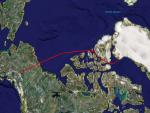
Larger image (new window) Download KMZ/KML File (right click, save as) |
Satellite Image from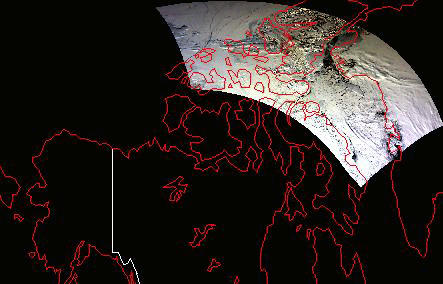
MODIS/Terra larger image (morning) (new window) MODIS/Aqua larger image (afternoon) (new window) |
Satellite Images from GOES-11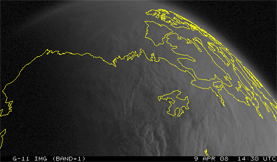 1430 - 2330 UTC |
CAR - (QuickLook)
Imagery from CAR Instrument
Click browse image thumbnail to load more detailed version (images open in a new window)
| Flight Direction | Flight Direction |
|
|
|
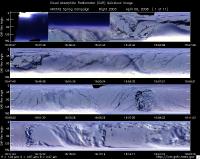
|
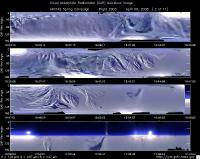
|
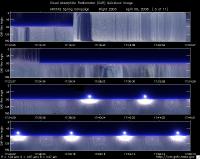
|

|
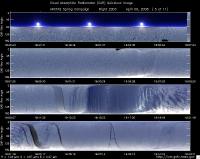
|

|
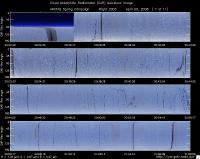
|

|

|

|

|
Flight Mission Details
Overview:
This was the 3rd flight starting from Thule Airforce Base to Alaska. Pre-flight goals included BRDF over ice/snow/clouds, and CALIPSO underpass. Look for Asian plume near Fairbanks.
P-3B instrument payload:
AATS: Ames Airborne Tracking Sunphotometer (AATS) measured direct solar beam transmission at 14 wavelengths between 354 and 2139 nm in narrow channels with bandwidths between 2 and 5.6 nm for the wavelengths less than 1640 nm and 17.3 nm for the 2139 nm channel. No significant issues reported.
AERO3X: measured aerosol extinction and scattering at 405nm and 675nm, scattering in Forward and Back directions at both wavelengths and NO2 mixing ratio.Aethalometer and f(RH) operated entire flight. Had issues with air flow.
BBR: Broad Band Radiometer measured: Down- and Up-welling Solar (0.2-3.6 µm) and IR Irradiance (4.2-42 micron).No issues reported.
CAR - Cloud Absorption Radiometer measured angular distribution of scattered radiation and acquired imagery of cloud and snow/ice surface features enroute to Fairbanks. BRDF measurements over ice and supercooled water clouds.
CCN Counter - Continuous-Flow Streamwise Thermal Gradient Cloud Condensation Nuclei (CCN) Counter (CFSTGC) - counted the fraction of aerosol particles that become droplets when exposed to a given water vapor supersaturation (RH > 100%). Worked well entire flight.
COBALT - Carbon monOxide By Attenuated Laser Transmission (COBALT), an autonomous instrument based on off-axis integrated cavity output spectroscopy took measurements of carbon monoxide. No issues reported.
HiGEAR - Hawii Group for Environmental Aerosol Research (HiGEAR) suite of instruments measured size resolved aerosols. SP2 recorded good data. AMS worked well. Low scattering entire flight.
PDS Project Data System (PDS) measured base meteorological and navigational measurements. No issues reported.
REVEAL - The Research Environment for Vehicle-Embedded Analysis on Linux (REVEAL) system is a prototype next-generation tool for aerospace vehicle sensor webs and the future Earth Observation System. Made good progress in testing the system. Was able to "serve" COBALT data to HiGEAR. Partial DC-8 tracks acquired.
SSFR -Solar Spectral Flux Radiometer measured spectrally resolved solar irradiance (380 nm to 2200 nm) over snow/ice and clouds. No issues reported.
Flight Path, Timing, and Measurements
Approximate time in UTC (Alaska time - 8 hours; Greenland time -3 hours). Activities during CAR flight 2001 on April 4, 2008 out of Fairbanks International Airport, Alaska heading north towards Barrow. Observations by CAR operator/PI, Charles Gatebe.
15:14 -- Engine on.
15:26 -- Taxing. (WFF flight report - timeout: 15:25).
15:33 -- take off.
15:35 -- CAR power on. CAR in park position scanning the sky from horizon to horizon.
15:45 - CAR scanning the surface from horizon to horizon perpendicular to the flight track.
15:47 -- Straight and level leg at ~6347 m msl.
16:25 -- over rugged terrain.
17:15 -- under a cloud. CAR scanning the surface from horizon to horizon perpendicular to the flight track.
17:21 -- Cloud above.
17:30 -- Cloud below. Setting up for BRDF measurements.
17:40 -- BRDF circle #1, over cloud. Filter wheel at 2.2µm.
17:42 -- BRDF circle #2. Roll/pitch problems.
17:45 -- BRDF circle #3.
17:49 -- BRDF circle #4.
17: 51 -- Filter wheel set to 1.6µm.
17:53 -- BRDF circle #5.
17:57 -- BRDF circle #6.
18:10 -- end of BRDF. AOD ~0.065 (@499µm).
18:34 -- BRDF circle #1, over sea ice.
18:37 -- BRDF circle #2
18:40 -- BRDF circle #3
18:44 -- BRDF circle #4
18:48 -- BRDF circle #5
18:50 -- BRDF circle #6
18:54 -- BRDF circle #7
18:55 - end of BRDF. Instrument imaging mode changed to scan the surface from horizon to horizon perpendicular to the flight track.
19:57 -- cloud below.
20:28 -- 60 m above sea ice.
20:47 -- reported aerosol gradient.
21:21 -- AOD ~0.33 at 0.499µm. At 60 m agl. BRDF at all NIR channels look very similar. Very low BRDF at 2.3 µm.
21:38 -- BRDF at 0.340µm = BRDF at 0.870 µm. Check ratio of BRDF-0.340:0.870 over clouds.
22:46 -- heading straight to Fairbanks.
23:10 -- Ozone =160/165 ppb.CO ~20 ppb/173 ppb.
23:30 -- final descent to Fairbanks.
23:34 -- Nav temp ~-35 deg. C.
23:54 -- CAR door closed.
24:07 -- Landed. (WFF flight report, timein:24:06)
